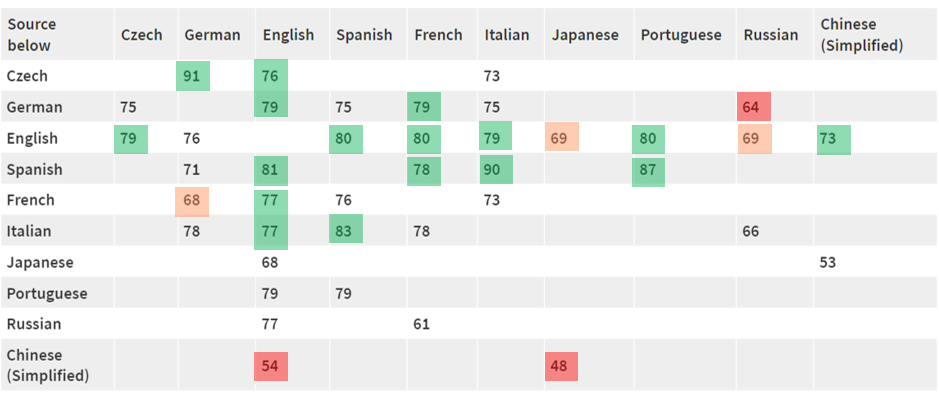Insights into the Functionalities & Use of Translation Hub
The news was released at the Cloud Next’22 summit in San Francisco on the 11th October 2022. Since then, the service has gone live and is already accessible to companies. The below analysis, put together by our technical team, has been elaborated with the purpose of guiding procurement choices, providing quick analyses of features and capabilities while answering the question of whether Translation Hub is a viable corporate translation tool and if so, how the software should be used.
At present the majority of Language Service and Translation Agencies already offer more than capable MT (Machine Translation) solutions as part of their service offering. Moreover, translation companies usually advise businesses on when this methodology is an appropriate solution for varying content types – which is not always. The MT services offered by a Translation Agency would typically consist of more than one machine translation engine in combination with human post-editing services.
What are the functionalities of Google Translation Hub?
Google Translation Hub provides a machine translation service based on the Google Translate engine. Documents to be translated can be submitted via an online portal which supports various formats, including Microsoft Word, PowerPoint and Excel. Once uploaded, the system pulls the relevant text from the document and runs this through Google Machine Translation to recreate the text in the target language.
Essentially, in its basic version, Translation Hub makes it easier and more practical to machine-translate whole documents via Google Translate. The platform also makes it possible for users to upload documents directly online, without having to copy and paste sizable chunks of text from the source language and paste it into another document where the target language is required.
As part of the advanced version, Translation Hub includes a post-editing step for human intervention. This means that translators can be involved in the post-editing phase of the process, reviewing the machine generated translations and checking the text for accuracy.
What are the pros and cons of Google Translation Hub?
The question is not so much whether Translation Hub is a replacement solution for the comprehensive services offered by language and translation companies: it clearly is not. The question is rather about the use of MT software as a tool for translation work, and in which specific circumstances it may be a good option for businesses.
Translation Hub allows the mass translation of documents, both quickly and cost-effectively. However, the key element that the tool is missing out on is the aspect of quality. Brands could theoretically run their content through an AI translation tool, translating their product brochures and the entirety of their website – in the same way they could do this piece by piece in Google Translate – but that isn’t to say that these methodologies will produce the desired results.
The limitations to such methodology are depicted in by using a triple constraint model (time vs. price vs. quality), which illustrates that there is an inevitable sacrifice to be made when combining fast and inexpensive translations. Although despite the Translation Hub limitations, it would not be fair to say that all AI-generated translations are entirely unusable, inaccurate or unfit for purpose. The onus should be to identify: what types of content would benefit from machine translation; which audiences are most suitable for machine translation; and what are the processes for post-editing and review that need to be set up to make sure that company/brand objectives are met. When combined with human post-editing and an efficient review process by professional translators, machine translation can be an extremely useful instrument to have in your global content-scaling toolkit.

The Triple Constraint Model: Time, Price & Quality
High Quality & Cheap = Not Quick
Cheap & Fast = Not Quality
High Quality & Fast = Not Cheap
For the purpose of illustrating, the types of content that our team considers to be inherently incompatible with MT includes prominent marketing content, high-visibility external communications, creative pieces and high-traffic website content, in addition to any text that is intended to be more emotive, thought-provoking or snappy. This also applies more broadly to headlines, straplines, puns, metaphors and any cultural content where there is a divergence in etymology.
Conversely, the case can also be made that MT (in combination with human post-editing) is more relevant for content such as lower-importance internal communications and less important web content. Again, the main advantage here is that MT makes it possible to generate high volumes of content that can be spread across selected audiences at speed.
All elements taken into consideration, we believe that the main weaknesses of Translation Hub are as follows:
1. One translation engine: Translation Hub is only based on the Google Translate engine. However there are many other neural translation engines out there, each with their own strengths. Locaria’s MT offer provides a unique blend of engines to improve the output quality, and reduces post-editing time.
2. Quality Risk: After translating documents into multiple languages, there is no way to evaluate whether or not the translation done by the machine is ‘good’ or ‘bad’. You need a professional partner to determine where and to what extent each text needs fixing.
3. Content Types: The type of translation can vary according to the purpose of the text. Some content may require a very different form of translation which is not necessarily covered under the Machine Translation capacities. For example, there is no filter to use more evocative language, to originate, ideate, transcreate or even localise.
4. Post-editing: Although a post-editing feature has been made available within the more expensive version of the Google tool, there is no in-house resource team that can help a business to carry out edits and review the final text. Businesses are left to manage the complexities and intricacies of vetting, selecting and coordinating the work of post-editors, which is a job typically best left to the experts, i.e. language and translation professionals. This is not a job for employees, friends or colleagues that speak the language.
5. Expertise and guidance: Clients need a range of tools and a partner to navigate them, not just a Google log-in. There are experts behind each piece of tech and each service, and choosing the company that can best support you in getting the right product is the real game changer. While Google may be aiming at getting more and more people to use their Cloud services (which is the sector they really want to dominate, not translation), a brand’s priority must be to identify the ideal partners and experts to help them with their global communications strategy.
6. Language/Vertical Combinations: Certain language combinations and verticals have varying levels of quality output. This is mainly due to translation memories being less populated with information and consequently the output may not live up to the standards of more popular language combinations, such as English-Spanish, and prominent verticals. As a result, there are more errors which require heavier post-editing.
 (Source: Memsource MT language pairing data – Q2 2022)
(Source: Memsource MT language pairing data – Q2 2022)
The Locaria Solution:
Locaria’s Machine Translation Post-Editing service offers a blend of selected translation engines (including Google Translate, but using several additional non-Google neural engines) and picks the best one based on a live algorithm which assesses quality across language combinations and verticals. Our post editors are then carefully selected based on vertical, experience and familiarity with the client.The end result is high-quality translation delivered at speed, with a lower cost price than more premium options.
What is our advice when it comes to the different translation options?
Over the past few years there has been growth in the use of machine translation services, and according to a report by the Common Sense Advisory, up to 12.7% of all language technology revenue in 2017 came from MT. This trend has since grown and is spurred by an increase in information exchange – there are higher volumes of content and an industry shift that pushes companies to actively engage with customers.
Machine translation tools produce texts that require some level of human intervention, post-editing and reviewing by a professional before being presented to the end user. To a certain extent, this methodology can be used for content such as internal communications and presentations of lower importance, where getting the essential ‘good enough’ message across is the main objective.
However, careful consideration should be taken before using this technology for any brand marketing content that may need more emphatic or emotive language, idiomatic expression, high-level accuracy, creativity and connection with the reader – this kind of content is where conversion and brand image is capital. Should machine translation be used in these instances, for example a full website translation, the results could be detrimental to brand image. This also presents the additional risk of miscommunication, content failing to engage its audience, sounding alien, off-brand and not as well written.
Brands should be looking for long-term agency partnerships and fostering relationships with translation companies that consistently understand their brand tone of voice, that help elevate their content and that care about honing their brand image. There are clear advantages to backing up choices with linguistic support and data, as well as having on-hand translation support to guide complex linguistic choices. Locaria proposes a solution that goes even further – not just owning the process, but also owning the outcome of mass-media campaigns to ensure that exacting linguistic standards and optimal performance levels are met.



